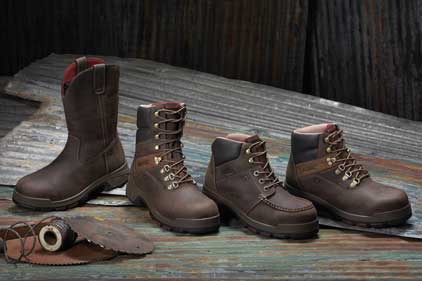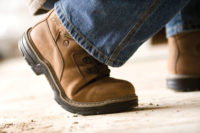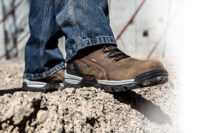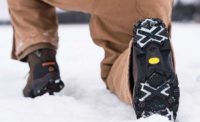Waterproof
The first line of defense against water is waterproof leather and upper materials often combined with internal seam sealing of the boot. This level of waterproof is cost efficient and is effective when used in relatively dry but occasionally wet environments such as rain, mud and puddles. Waterproof leather is durable and breathable, ensuring feet can stay cool and comfortable. This level of waterproof becomes less effective when boots would be periodically and partially submerged in water or when the presence of water is relatively constant.
A higher level of waterproof is available for situations where boots are apt to be exposed to water for longer and sustained periods of time. At this level, a waterproof membrane is built into the lining of the boot, providing a barrier that prevents any water from entering inside the boot. Boots with a waterproof membrane are highly effective on jobs when boots are continuously exposed to water day after day. Waterproof membranes offer longer-lasting, dependable and durable protection against water. Some waterproof membranes have breathable qualities which, in addition to keeping water out, allow moisture from inside the boot to escape. This breathability keeps feet dryer and cooler and therefore more comfortable. Technology like a GORE-TEX waterproof breathable membrane guarantees that feet stay dry in wet conditions while still maintaining excellent breathability.
Insulation
Insulation is another important consideration for many people who work outside in colder environments. Insulation typically ranges from 200 grams for light warmth to 1200 grams for use in the coldest, harshest conditions.
Insulation like Thinsulate is made of microfibers that trap air molecules between your foot and the cold outside air. The more warm air the insulating material is able to trap, the better it insulates the inside of the boot from the cold air outside. 1200 gram insulation is warmer than 200 gram insulation for this reason. Lower gram weights of insulation (like 200 and 400) are best suited for people who are outside in the cold and active most of the time. Higher gram weights (800, 1000 & 1200) are more appropriate for types of work in extreme cold coupled with periods of inactivity.
Boot types
Hiker: Hikers are a versatile, comfortable style of work boot. Athletically-influenced hikers are often lightweight and great for people who have to cover a lot of ground in their work. Generally speaking, these types of boots work best in lighter-duty environments that do not require the boot to provide higher levels of protection, support or durability.
Six-Inch Boot: A traditional six-inch work boot offers more ankle support than even a mid-cut hiking boot, which means more stability and protection as well. Available in an ever-increasing amount of upper materials and overall aesthetics, six-inch boots provide a hard to beat combination of comfort and support.
Eight-Inch Boot or Taller: Lace-up boots eight inches and taller build on the strengths of the shorter six-inch version. They offer additional support and security, and the extra height will help keep out snow in winter conditions, as well as provide an additional area of protection on the leg from items brushing or hitting against it. Eight-inch boots often have a rugged lug outsole with a pronounced heel to help navigate rough and uneven terrain. They are usually made of all leather and feature a Goodyear welt or direct inject construction, making them incredibly durable. The downside to such boots is that they tend to be heavier and bulkier than their hiker and six-inch cousins.
Wellingtons: A Wellington is usually a 10-inch pull-on boot that has no lacing. The biggest benefit of this style boot is that they are easy-on and easy-off. They also have a distinct western-influenced style, and offer a looser, roomier overall fit. Six- or eight-inch boots will offer more secure and supportive fit around the ankle, but in many jobs where this is not a priority, a Wellington is a convenient and preferable option.



